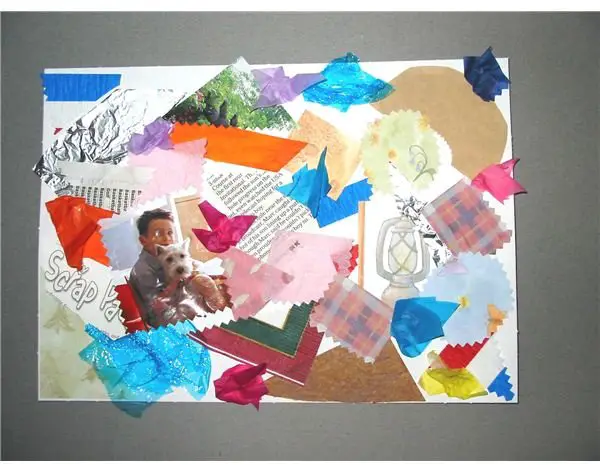Collage Making: Learning About This Art Technique
I recently had the opportunity to review a new book, Playing with Collage by Jeannie Baker (Candlewick Studio, October 2019). This book is the perfect resource to collage making and teaches the various techniques and the variety of materials you can use for this art.
The word “collage” originates from the French word “colle” that means glue or paste. Paper and other small materials are pasted onto another surface. The art is colorful and some have texture. Drawing on top of the adhered collage materials only enhances the pictures.
Collection Box
To begin collage making in school or at home, I suggest keeping a box to collect materials. Anything that can be glued onto paper or a board can be used. Think about papers (tissue, gift wrap, magazines, newspaper, scrapbook paper) along with foils, wallpaper, greeting cards, photographs, paint chips, and sandpaper, just to name a few items. Then add in some recycled materials, like pieces from Styrofoam trays, bubble wrap, yarn, fabrics, paper plates, egg cartons, etc. These materials add dimension to your collage project. As your collection box grows, your kids have more materials for creative collage projects. Baker devotes several pages in her book on ideas for your collection box.
What’s Your Theme?

Mixed-media collage making
A collage can be open-ended, but choosing a theme keeps the project in a direction. For example, you can make a nature collage full of fallen leaves, flowers, grasses, feathers, and even small seedlings. If you are leaning toward a beach theme, your collage board could contain sand, broken shells, sponge, and dried seaweed.
Other collage themes could be a vacation where kids arrange memorabilia (ticket stubs, pictures, brochures, menus, and such) on a page. How about a symbolic holiday collage? Then, there is the kitchen collage with beans, seeds, spices, and skins from produce.
Any inspiration is the means for kids to use their thinking skills and hands-on abilities to create art.
Collage in Books
As you read books from author/artist Eric Carle, you will see his glorious forms of torn paper collage. Check out such titles as The Tiny Seed, The Mixed-Up Chameleon, and his infamous The Very Hungry Caterpillar. Eric Carle has applied his artistic talent to over 70 titles.
Lois Ehlert combines cut out paper images with loads of color and real objects of nature to make collages for her storybooks including Red Leaf, Yellow Leaf, and Feathers for Lunch.
Nina Crews created a photo collage in her book I’ll Catch the Moon. Sarah Josepha Hale authored Mary Had a Little Lamb and along with Tomie dePaola used scraps of old clothes and fabric to illustrate this book.
Leo Lionni loves to use textured collage in his books, including Swimmy, Inch by Inch, and Frederic. Your children can explore texture in the classroom by making crayon rubbings. Give them materials such as sandpaper, coins, burlap, a comb, etc. and allow them to place sheets of paper on top and rub with the side of a crayon. After the rubbings are complete, cut out these images and arrange them into a colorful freeform collage.
The author, Jeannie Baker, of the featured book Playing with Collage, has other books published with mixed media collage. You can check out The Story of Rosy Dock, and Window, where she has reconstructed realistic life using fabrics, papers, natural materials, and more. Her art is basically repurposing materials to make another product.

One of my favorite forms of collage is simple for young children. Place a sheet of clear adhesive paper onto a tabletop. Use some tape to hold this in place, sticky side up. Invite the kids to arrange all kinds of materials (anything that is somewhat flat) onto this sticky paper to make a collage. Cover the finished art with another sheet of clear adhesive paper. Voila! A unique piece of collage by your students.

Sticky paper pumpkin collage
Make sure your students have the opportunities to view the books above to visualize all the techniques that collage has to offer. And, then bring out the collection box and allow the children to make their own creations. As Jeannie Baker quotes, “you can create artworks of your own from the wondrous world around you.”
Feature photo from the book, Playing With Collage
Other photos by Tania Cowling, all rights reserved
